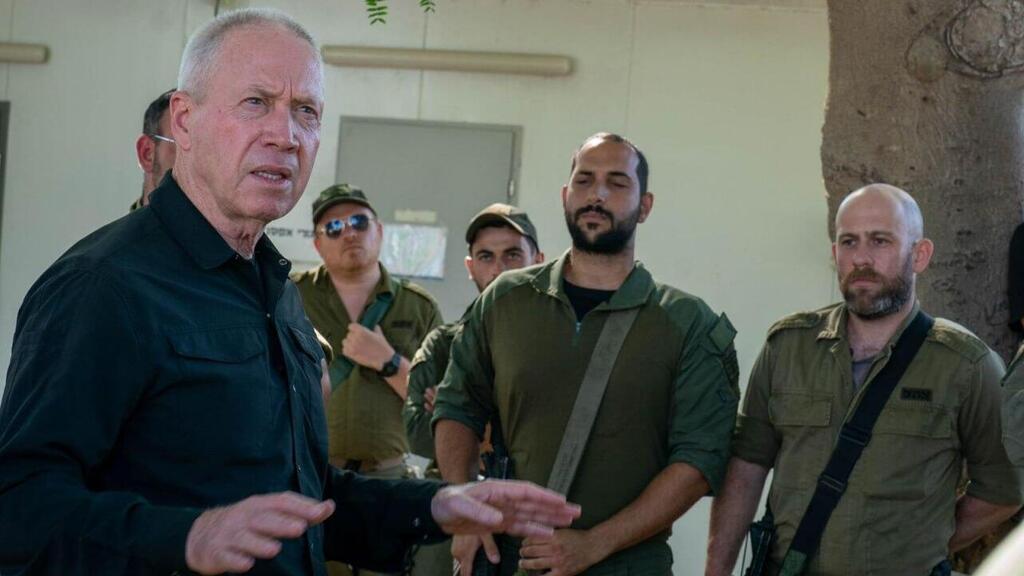Getting your Trinity Audio player ready...
Following the assassination of Hamas leader Ismail Haniyeh in Tehran and the expected Iranian response, questions have emerged about whether Israel will activate its underground bunker in the Jerusalem hills if simultaneous war breaks out with Iran and Lebanon. The answer remains uncertain, depending on developments that could escalate into a regional conflict.
Preparations have been made to operationalize the National Emergency Management Center (NEMC), a complex of underground bunkers in Jerusalem intended for state leaders during a combined attack by Iran and Hezbollah. However, sources suggest Prime Minister Benjamin Netanyahu is more likely to manage any upcoming conflict from the Defense Ministry headquarters in Tel Aviv, as he did on October 7, rather than from the NEMC.
3 View gallery


Prime Minister Benjamin Netanyahu in the Defense Ministry headquarters in Tel Aviv
(Photo: GPO)
The Walla News website reported on Tuesday that sources close to Netanyahu indicated that he and his wife Sara and son Yair plan to enter the underground complex in the event of an Iranian attack on Israel in retaliation for recent assassinations. Adding to the speculation, rumors suggest Sara Netanyahu was recently seen at the site. The Prime Minister's Office, however, denied these claims, calling them "complete fake news."
Another indication that the NEMC might be activated is the threat from Iran and Hezbollah to target Israeli officials with precise missiles in retaliation for the assassinations of senior Hamas and Hezbollah figures. Netanyahu, who has expressed concern over the missile threat, has frequently changed residences since the October 7 war, moving between the official residence on Jerusalem's Balfour Street, a private apartment on the capital's Aza Street, a villa in Caesarea, and reportedly, a villa owned by billionaire Simon Falic in Jerusalem's Talpiot neighborhood, which is said to have an atomic bunker. He has also reportedly stayed at the homes of his close associate Zack Gertler and in various hotels.
Given the threats and the extended combat of the current conflict, which Netanyahu has described as Israel's "Second War of Independence," questions arise as to why the Israeli government chose to manage the war from the Defense Ministry headquarters in Tel Aviv instead of the underground bunker in Jerusalem. The NEMC was established at a cost of billions.
A senior political source explained earlier this year that the NEMC is ready for action, but there has not yet been a warning of a scope that necessitates its use. In other words, the defense establishment has not considered the threat level sufficient to activate the NEMC. The source emphasized that this is a "purely professional consideration" and that "parts of the NEMC are operational and ready if needed."
However, various sources questioned why the current war was not managed from the NEMC, arguing that managing the war from the Defense Ministry headquarters blurs the lines between military and civilian management.
The NEMC's role is to enable functional continuity for civilians, which requires operating parallel to the military, not within it. Since the war began, there have been numerous complaints about the government's performance, attributed to the military-centric management approach, exemplified by the non-use of the NEMC.
Visitors to the NEMC have described it as well-maintained and in good condition, but representatives from various organizations prefer to remain in their offices rather than work deep underground.
A modern Noah's Ark, protected from all threats
The underground bunker complex in the Jerusalem hills is protected from all possible threats: earthquakes, nuclear, conventional, chemical, biological attacks and cyberattacks. In 2018, Netanyahu convened the Cabinet in the NEMC several times, but these meetings were during peacetime, not war.
The decision to build the NEMC came from the lessons of the 2006 Second Lebanon War. The project, estimated to cost billions, was executed by the Defense Ministry and included constructing conference halls and meeting rooms deep underground—specific details are classified—where the government would manage the state during emergencies.
Leaks from confidential meetings, often lamented by Netanyahu, are impossible at the NEMC due to its underground location, which blocks cellular reception. Anyone entering the bunker must leave their phone at the entrance, making it impervious to surveillance and ensuring that discussions remain secure. From a security perspective, the bunker is completely sterile.
The NEMC is designed to house the Israeli government and various civilian agencies in the event of an all-out war, whether under missile attack or, in a worst-case scenario, during a nuclear conflict. First revealed in 2007 by Ynet's sister publication Yedioth Ahronoth, the atomic bunker has since remained shrouded in secrecy.
Planning the infrastructure in the Jerusalem hills, envisioned as a modern "Noah's Ark," took years and was based largely on similar underground "security cities" in the U.S. The site can accommodate hundreds, including ministers and key officials, with facilities ranging from sleeping quarters to spacious work areas and a large dining hall. "It's a place that instills awe," said one of the few who have seen the finished bunker. "From here, they will command a burning nation."
During 2014's Operation Protective Edge, some significant attacks were managed from the NEMC. Visitors describe the structure as highly impressive, resembling a sophisticated war room with numerous screens and control stations. The government and Cabinet have conference rooms with comfortable chairs, and the prime minister and defense minister have offices adjacent to the meeting rooms. Additionally, the NEMC contains dozens of other offices for various uses.
More than 95% of the NEMC is underground, accessible via spacious elevators. "The elevators are very fast," said one visitor. "Descending into the earth feels like a sci-fi movie. Inside the bunker, you feel completely isolated from the world, but without any sense of claustrophobia." Unlike the Cabinet office in the Prime Minister's Office, ministers cannot bring assistants and advisors into the bunker, "so you are entirely alone there."
Defense Minister Yoav Gallant was responsible for drafting the bunker specifications and determining the balance between different systems, especially between the government and security bodies, about 20 years ago when he served as military secretary to then-Prime Minister Ariel Sharon. "It's no wonder," said one minister, "that the final result resembles a kind of submarine—Gallant comes from Shayetet 13—where you need to optimize limited space."





